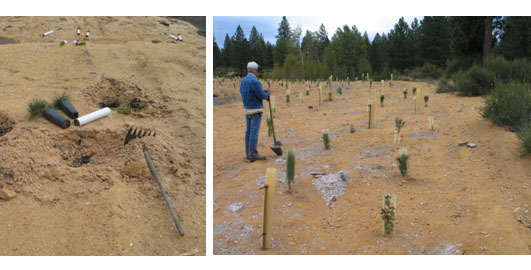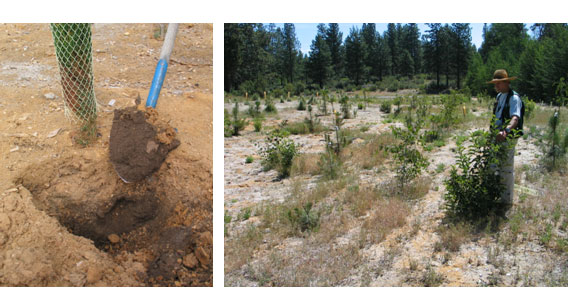ROADSIDE REVEGETATION
An Integrated Approach to Establishing Native Plants and Pollinator Habitat
Learn
Sawdust as a Mulch on Obliterated Road Sections
| Location: | Chiloquin Highway - Hwy 422 |
| Lat/Long: | N42o35'32.1", W121o53'37.32" |
| Dates Implemented: | Fall 2003 and late Winter 2004 |
| Client: | Western Federal Lands Highway Division |
| Planners: | R6 Restoration Services Team |
| Contractors: | Stone Nursery |
| Case Number: | 0005 |
| Date Submitted: | December 2008 |
| Focus Area: | Mulch, Plants, Planting Pockets |
Background and Objectives
The realignment of the Chiloquin Highway left five sections of abandoned road. The revegetation objective was to reestablish vegetation on these obliterated road sections to match the surrounding ponderosa pine/bitterbrush plant community. The substrate left after the pavement was removed consisted of a sandy pumice subsoil, high in rock fragments, and chunks of road pavement. Unfortunately there was no topsoil to apply over the obliterated road segments. The main limiting factors to plant establishment were the low soil water holding capacity, semi-arid climate (an average of 2 inches of rainfall occurs between June 1 and Sept 31), and low soil nutrient levels. We selected a treatment of applying a mulch to the soil surface to conserve soil moisture by limiting surface evaporation and maintaining a site relatively free of competing vegetation. The additional soil moisture would be available to planted tree and shrub seedlings for most of the summer.
Implementation
In fall 2003, 2,000 yards of fresh sawdust was applied to three abandoned road sites. The sawdust was a fine textured, waste product originating from Medite Corp mill in Medford OR1. The only expense associated with this material was hauling it to the site (an 80 mile distance). Material was spread at a 2 to 6 inch depth with the blade of a tractor. After application, the site was fertilized with 2,000 pounds per acre of Biosol (a slow release, organic fertilizer). The entire road was then ripped to an 18 inch depth with a subsoiler.
Seedlings were auger planted in early March 2004, immediately after snow melt. Planted species were ponderosa pine, bitterbrush, serviceberry, quaking aspen, Klamath plum, and choke cherry. The stocktypes were "long tubes" and one gallon "tall pots". Tree shelters were place around quaking aspen, bitter cherry, and service berry to increase survival.
Findings
Monitoring during the first summer after planting showed that soil moisture remained high (see figure). This was due to the reduction of surface evaporation, as well as the lack of unwanted vegetation. The effects of high soil moisture showed up in the pre-dawn plant moisture stress measurements that were take with a PMS machine at monthly intervals in the summer. The ponderosa pine seedlings did not exceed moderate stress levels (<10 bars).
First year monitoring showed that over 85% of the plants survived (except for the bitterbrush which had a 65% survival rate). Many of the ponderosa pine were infested by the cone worm insect (Diaryctria sp). This insect lays eggs on the buds of the terminal leader of the tree and the hatching larvae mine through the new leader, destroying the new leader. This happened two years in a row, affecting the growth and survival of pines on certain sections of obliterated road. Bud caps were installed with varying degrees of control. After three years stocking of most species was adequate aside from one area where the cone worm had weakened most of the trees.
Figures
One gallon containers and long tubes were planted below the sawdust in the March 2004 in clumps of three to four plants (left photograph). The picture on the right was taken in September 2004 and shows no invasion of unwanted vegetation.

The photograph on the left was taken in September 2004, after a warm, dry summer, showing that soil moisture remained high under mulch throughout the summer. The picture on the right was taken at the end of three growing seasons and shows that some unwanted vegetation had become established but most exhibited very low vigor.

Applicability
Fresh sawdust performed well as a mulch even though it was very fine textured. Soil moisture remained in the soil longer during the growing season than soils that were not mulched. The presence of unwanted vegetation was minimal in the years after sawdust application, a critical time for seedling establishment. Part of the reason unwanted vegetation did not populate the site was due to the high C:N ratio (very low soil nitrogen) of the sawdust. The seedlings, on the other hand, were planted below the mulch in soils where the C:N ratio was lower and access to soil nitrogen greater. Applying fresh sawdust at these depths on other projects would not be effective if stands of grasses and forbs were desired. An alternative would be to plant seedlings in clumps, or "planting islands", and apply a thick mulch only to these areas, sowing the areas between the planting islands in grass or forb seed. Not only would this save money on mulch, it would increase plant diversity.
Related Links
Chiloquin Highway Revegetation Project Final Monitoring Report (4.62 MB PDF)
Technical Guide, 10.1.8.4 Planting Islands
Contact Information
David Steinfeld, USDA Forest Service; 541-552-2912, dsteinfeld@fs.fed.us
1This material had been used at Stone Nursery as a soil amendment for several years leading up to this project